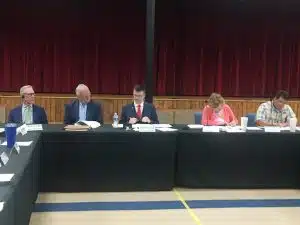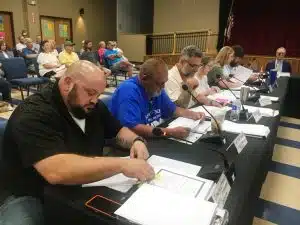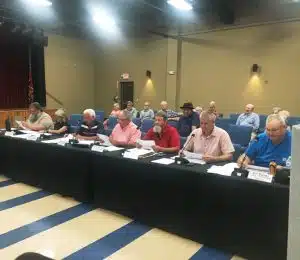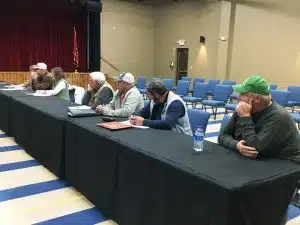News
County Mayor Casts Tie Breaking Vote in Favor of 51 cent Property Tax Increase and $65 Million Bond Resolution for Judicial Center/Jail
June 25, 2024
By: Dwayne Page
For the second year in a row, your county property taxes are going up!
During Monday night’s regular monthly county commission meeting, County Mayor Matt Adcock, as chairman of the commission, cast not one but two tiebreaking votes including one for a 51-cent tax increase putting the new tax levy at $2.51 per $100 of assessed value and another giving the county authorization for an initial bond resolution for up to $65 million to build a judicial center/jail. The commission was deadlocked at 7 to 7 on both crucial votes before County Mayor Adcock broke the tie in each case.
The public can have a voice on the bond resolution to fund the judicial center/jail project.
According to terms of the public notice, “the public has 20 days from the date of publication to file with the county clerk a petition signed by at least 10% of the registered voters of the county protesting the issuance of the bonds”. That could force a referendum.
This marks the second year in a row that the county property tax rate has been increased. Last year property owners were saddled with a 27-cent increase with the rate at that time going from $1.7308 cents to $2.00 per $100 of assessed value. The entire 51 cent increase this year will go to the debt service fund to support the proposed judicial center/jail project.
Commissioners voting in favor of the $2.51 property tax levy (51 cent increase) were Jeff Barnes, Andy Pack, Tony (Cully) Culwell, Glynn Merriman, Mathias Anderson, Larry Green, Tom Chandler, and Chairman-County Mayor Adcock. Voting against were Commissioners Daniel Cripps, Susannah Cripps, Sabrina Farler, Greg Matthews, Myron Rhody, Beth Pafford, and Tony Luna.
The original proposal was to increase the total tax levy by 61 cents to $2.61 per $100 of assessed value but the commission, during an earlier vote in the meeting, removed the 10 cent increase to schools ($630,000) and instead allocated another $370,000 from the local purpose (sales tax) fund giving schools a total contribution annually of $1,910,000 which is an increase from the $1,540,000 the county has been allocating from the sales tax fund each year for school operation.
Commissioners voting in favor of removing the 10-cent property tax increase and adding the $370,000 in sales tax funding to schools were Glynn Merriman, Mathias Anderson, Andy Pack, Daniel Cripps, Susannah Cripps, Jeff Barnes, Tony (Cully) Culwell, Myron Rhody, Sabrina Farler, Larry Green, Tony Luna, and Tom Chandler. Voting against was Beth Pafford and Greg Matthews abstained.
On the Initial $65 million Bond Resolution, Commissioners voting in favor were Jeff Barnes, Andy Pack, Tony (Cully) Culwell, Mathias Anderson, Glynn Merriman, Larry Green, Tom Chandler and Chairman- County Mayor Adcock. Voting against were Commissioners Sabrina Farler, Daniel Cripps, Susannah Cripps, Greg Matthews, Myron Rhody, Beth Pafford, and Tony Luna.
The subsequent detailed bond resolution for up to $65 million for the judicial center/jail project was adopted on an 8 to 6 vote by the commission. Voting in favor were Tom Chandler, Glynn Merriman, Tony Luna, Larry Green, Andy Pack, Mathias Anderson, Jeff Barnes, and Tony (Cully) Culwell. Voting against were Beth Pafford, Myron Rhody, Greg Matthews, Daniel Cripps, Susannah Cripps, and Sabrina Farler.
Commissioner Matthews said while he favors the county building a justice center, he doesn’t like the way the bond resolution is written which could include funding for other projects such as a fire truck or ambulances.
Steve Bates, the county’s fiscal agent, explained that while the county could only borrow up to $65 million under terms of the bond resolution and would borrow only what is needed up to that amount for funding a judicial center/jail project, excess proceeds and interest income from the bonds could be used for other expenditures identified in the bond resolution such as county building improvements or purchases of emergency vehicles.
“You are only going to borrow what you need to pay for the project (judicial center/jail) plus cost of issuance,” said Bates. “If you have any excess proceeds, you can spend it on something else. You can’t borrow in excess of what you need under the law and you can only spend bond proceeds for whatever is defined in the bond resolution. If the bid comes in at $59 million you sell $59 million in bonds but you don’t know how much bond premium or interest income you’re going to get. I’ll calculate that after bonds are issued. If you earn a half million dollars or $700,000 more in interest or excess proceeds than I calculate, you can use that money for items defined in that bond resolution. If not, you’ll have to find another way to fund those projects,” said Bates.
During a meeting in mid-May, the budget committee voted unanimously to include in the bond resolution, when sent to the county commission for approval, a total of $910,000 ($425,000 for a new fire truck and a total of $485,000 for two new ambulances) to be funded from any excess proceeds or interest income from the bonds.
The reason for the move was to keep from having to spend so much from the county’s capital projects budget in 2024-25. That fund is designated for capital outlay expenditures such as building improvements and purchases of county vehicles, etc.
Although it failed earlier in the meeting, the amended appropriations resolution (including non-profits) was ultimately adopted on an 8-5-1 vote with a consolidated budget statement of individual funds (county general, schools, highway department).
Voting in favor were Commissioners Jeff Barnes, Daniel Cripps, Tom Chandler, Larry Green, Andy Pack, Mathias Anderson, Glynn Merriman, and Tony Luna. Voting against were Commissioners Susannah Cripps, Sabrina Farler, Beth Pafford, Tony (Cully) Culwell, and Myron Rhody. Greg Matthews abstained.
Commissioner Culwell said he voted no because he wanted to cut some funding to certain non-profits.
“If we are going to raise our county taxpayers’ dollars, we are going to have to show an effort that we are trying to quit spending money in some places,” said Culwell.
DeKalb Voters to Decide $50 Wheel Tax in November Referendum
June 25, 2024
By: Dwayne Page
Should DeKalb County have a $50 wheel tax?
Local voters will get to decide that question in November.
During Monday night’s monthly meeting, the county commission adopted an amended resolution to have a public referendum placed on the ballot for an up or down vote on a $50 wheel tax instead of the original proposal for $100 to support the debt service fund.
If approved, County Mayor Matt Adcock said the revenue raised from the wheel tax will offset somewhat the 51-cent tax increase for debt service and bring the property tax hike for debt service next year (2025-26) down from 51 cents to 33 cents.
Commissioner Tom Chandler made the motion to amend the resolution to a $50 wheel tax saying he thought it would have a better chance of being approved by the voters than a $100 wheel tax. The resolution, as amended was adopted on a 13-1 vote. Those in favor were Myron Rhody, Beth Pafford, Larry Green, Tony Luna, Tom Chandler, Andy Pack, Mathias Anderson, Glynn Merriman, Daniel Cripps, Susannah Cripps, Jeff Barnes, Sabrina Farler, and Tony (Cully) Culwell. Greg Matthews voted no saying he didn’t like how the resolution was written.
Are your county property taxes going up? Find out tonight (View pdf of proposed 2024-25 county budget here)
June 24, 2024
By: Dwayne Page
Are your county property taxes going up? Find out tonight.
During the monthly meeting tonight (Monday, June24) the county commission will consider establishing an overall property tax levy of $2.61 cents per $100 of assessed value to fund the proposed 2024-25 consolidated budget. That’s a 61-cent hike from the current tax levy of $2.00 per $100 of assessed value. A year ago, the rate was $1.7308 cents. The commission will also consider adopting an initial and detailed bond resolution not to exceed $65 million for the construction of a judicial center/jail.
Fifty-one cents of the proposed tax increase would go to fund debt service for a judicial center/jail while the remaining 10 cent increase would be allocated to schools to help fund the proposed new school budget which includes pay raises for certified personnel and support staff.
The county commission will also likely act on a resolution to have a public referendum on the ballot in the November election asking DeKalb County voters if they would support a $100 wheel tax for debt service to fund construction of a judicial center/jail. If approved by the voters, County Mayor Matt Adcock said funds from the wheel tax could help offset what a proposed property tax increase would generate in the meantime for debt service and allow the county to eventually scale back the size of the overall tax hike for the 2025-26 fiscal year after the wheel tax proceeds start coming in.
A public hearing on the proposed consolidated budget and property tax levy will be held at 6 p.m. tonight (Monday, June 24) prior to the monthly county commission meeting at 6:30 p.m. in the auditorium of the Mike Foster Multipurpose Center.
The agenda for the meeting is as follows: Call to order; invocation; pledge of allegiance; roll call; public comments; approval of agenda; approval of minutes; financial reports; budget amendments; committee reports; and new business including: appointment of DeWhite Utility District board members (James Hodges, Leslie Enoch, and Arthur Primrose); appointment of beer board members (Larry Green, Myron Rhody, Beth Pafford, Tony (Cully) Culwell, and Jeff Barnes); action on beer board policy and procedures; action on sales tax agreement; action on wheel tax referendum resolution; action on initial and detailed bond resolution; action on the nonprofit resolution; action on the appropriations resolution; action on tax levy resolution; approval of notaries; and any other business properly presented.
« First ‹ Previous 1 134 224 232 233 234235 236 244 334 2566 Next › Last »











